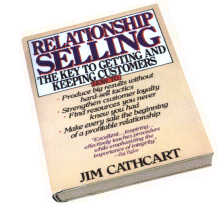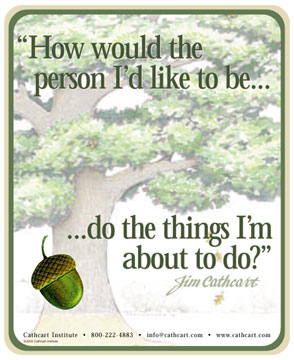MEDIA ANNOUNCEMENT
For Immediate Release
May 28, 2008
JIM CATHCART – WELL-KNOWN BUSINESS GURU AND PROFESSIONAL SPEAKER – ACCEPTS APPOINTMENT OF SENIOR ADVISOR AND SPOKESPERSON FOR SYNERGYSTREET.COM
Charlotte, NC – Tony Holden, founder of a new social networking site for business owners and entrepreneurs at www.SynergyStreet.com, has announced that Mr. Jim Cathcart has accepted the appointment of Senior Advisor and Spokesperson for SynergyStreet.
Jim Cathcart, CSP, CPAE, one of the most widely recognized professional speakers in the world, is founder and president of Cathcart Institute, Inc. and an advisor to the Schools of Business at Pepperdine University and California Lutheran University. As the author of 14 books and scores of recorded programs, his students number in the hundreds of thousands. He is a past president of the National Speakers Association (NSA), winner of the Cavett Award, member of the Speaker Hall of Fame (CPAE), Certified Speaking Professional (CSP), a member of the exclusive Speakers Roundtable, 20 of the world’s top speakers, and, in the year 2001, recipient of the Golden Gavel Award from Toastmasters International.
How SynergyStreet got connected with Jim Cathcart:
“Jim Cathcart is a master of growing High-Value Relationships. His own career is a reflection of this. When you list the names of the top speakers and authors in the business community you are also naming Jim’s contacts list. He’s in their address book and they are in his. I’ve seen him in action since 1989 and have been impressed with how widely admired he is among his colleagues and customers. He has received just about every honor that is bestowed upon professional speakers.”
Page Two
“Jim’s level of integrity, business acumen and reputation are what SynergyStreet wants for everyone. We know of no one more qualified to represent our community in the marketplace. We are thrilled that he has agreed to represent us as our Spokesperson and Senior Advisor. We encourage everyone to acquaint themselves with Jim by checking out his profile, blog and links to the storehouse of valuable information he has provided to the community at large and through his professional services as a speaker, author and trusted advisor.” –said Tony Holden, Founder & CEO of SynergyStreet.com
What Jim Cathcart has to say about SynergyStreet: “Today is the day for you to connect with as many trusted friends as you can and SynergyStreet is the place to do it. We grew up thinking that ‘Knowledge is Power’ and then discovered that the internet makes most knowledge available to everyone. So where is Power today? It is TRUST. The person with the most trust and acceptance among others is the person with the most power to succeed. Nobody makes it alone; we all need each other more than ever. “
“With SynergyStreet you now have a system within which you can connect and collaborate easily and safely. As you build your own community of trusted colleagues and friends you expand your capacity for success. Our goal at SynergyStreet is to make it easy and fun for you to conduct business and grow friendships. Our focus is bringing you Commerce, Community and Collaboration to expand your potential to succeed.”
Page Three
Cathcart Institute, Inc. has published a wide variety of learning resources in the area of human development. All of these are available as live in-person training programs as well as published works. Topics covered include: Sales Skills, Leadership, Professional Development, Self Improvement, Relationship Skills, Public Speaking, Self Motivation, Managing People, Psychology, Personality Styles, Sales Management, Marketing, Customer Relations, Customer Service Strategies, Strategic Planning, and Communication Skills.
Speech Topics include: Relationship Intelligence ™, All Leadership Begins With Self Leadership, Relationship Selling™, The Acorn Principle™: (Helping People Grow), Guaranteeing Lifetime Customer Loyalty, and Behavioral Economics: Every Action Has A Value or A Cost.
Jim Cathcart’s works are published by the world’s top publishers: St. Martin’s Press, Leading Authorities Press, Dartnell, Penguin Putnam, Macmillan India, Prentice Hall, Nightingale Conant and the University of Southern California. Relationship Selling is now translated into Chinese, Japanese, German and Finnish. Jim’s works are available in print, on DVD, CD and online.
SynergyStreet considers Jim Cathcart to be exactly the kind of person who belongs on SynergyStreet.com and we welcome him as he welcomes you to our community. As Jim often says, “Join us and let’s discover just how much more successful you can be!”
End
Caption: Jim Cathcart – Senior Advisor & Spokesperson to SynergyStreet.com
www.synergystreet.com
For further information on this announcement contact:
Dianne Stewart
BSA Public Relations & Marketing
704 .844 .1064 / 704 .777 .4842
Di@BSAPR.biz




